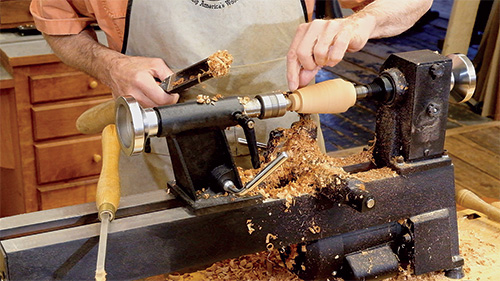
How does one attach dust collection to a lathe to get the majority of the chips?
Sandor Nagyszalanczy: Unless you’re sanding a turning, the chips produced during turning tend to be quite sizeable and hence, difficult to “entrain” (capture via suction) into a dust collection system. I’ve seen pros set up a rig where they position the end of at least a 4″ diameter dust collection hose so that it’s positioned directly opposite the turning in the area where it’s being cut with the turning chisel. The idea is to orient the open end of the hose so that the chips fly directly into it like little fish swimming into the gaping maw of a whale. To slightly expand the chip-catching coverage of your hose, you can attach a funnel-like transition fitting (round to square) or nozzle. For greatest flexibility, you can mount your hose by attaching a rail to the wall behind your lathe and simply use bungee cords to hold the hose in position.
John Swanson: There is dust collection and chip collection. For chip collection, use a garbage can separator on a dust collector that has a rating of at least 1,200 cfm (cubic feet per minute).
John Brock: I use a couple of different methods at the same time. I have an attic fan installed in the wall that exhausts under my front porch. It keeps the dust away from my face and out of the shop. Additionally, I have a 4″ hose from my dust collector on an articulated arm that I can position above the spinning stock. It feeds into a two-stage filter to separate the big chips from the dust. I also turn African blackwood on my metal lathe for making and repairing bagpipes. I have a 2″ hose from another dust collector on a magnetic base that is attached to the lathe apron. As the tool post advances with the lead-screw, the dust collector inlet is kept directly in the chip flow. It makes a huge difference.
Carol Reed: Turn a large funnel and attach it to a stand. Others have used AC/heating register ducts mounted on a stand behind the lathe.





